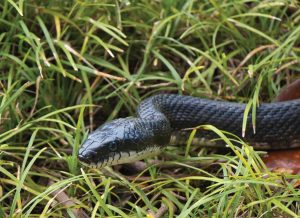Here we go ’round the mulberry bush, the mulberry bush … early in the morning. That nursery rhyme makes me think of red mulberry, indigenous to Illinois. To find a mulberry tree, all anyone need do is follow the parade of wild creatures headed that way when the berries are ripe. Name a songbird and it is probably in the lineup. I enjoy seeing the cedar waxwings that flock in, seemingly dressed for the occasion with dark eyeliner across their faces, feathered topknots on their heads, and highlights of yellow on tips of tail and red on wings. Once I even saw a groundhog 15 feet up in a mulberry tree – yes, a groundhog.
Mulberries are delicious. Sweetest and juiciest when dark red or nearly black, the berries taste especially good because they are among the first wild fruits of summer.
My favorite mulberry tree is a tall multi-trunked one, which probably sprouted 25 years ago on the barnyard side of the pasture fence. With a rounded crown and low branches curving downward, it merrily shades the chicken pen and produces berries that are nearly as big as the tip of my thumb. Picking those mulberries is a joy! They go into the pies I often find myself serving off the tailgate of the work truck as the tractor and planter idle momentarily.
On our farm, wheat harvest follows quickly behind planting season, and if I’m not hauling grain, then I’m picking raspberries, my favorite. Wild black raspberry is in the rose family. The stems bear thorns, but a little bloodletting is worth it, if, after an hour of picking, my recycled gallon ice cream pail is full of raspberries.
Berry-producing wild raspberry canes can be found in partial shade, where the absence of mowing or grazing has allowed growth for at least two years. It was along a fence line beside a road ditch in a busy metropolitan area where my young son, who was hating apartment living, found a super raspberry patch. The homemade raspberry jam he brought home and gave everyone for Christmas was very good.
Often in July, my husband and I have companionably trudged through the tall prairie grasses and waded into the briar patches growing around the old pond in our restored wildland. Some summers we bring home a load of wonderful blackberries, but it’s the chiggers that make the most lasting impression on me. Adorn yourself in a long-sleeved shirt, light-colored pants perfumed with insect repellent, boots, and don’t forget a cap or sunbonnet. Take the advice of the rhyme. Go early in the morning or try to avoid the hottest part of the day. Wild edible fruit-bearing plants abound in Illinois; however, if you don’t own the land, ask permission before you pick, even on public lands.
Berries are full of nutritional value, vitamins, antioxidants, minerals, fiber and all that jazz! Picking berries is a very merry adventure. Especially adventurous is the hunt for a certain ruddy orange-colored spherical berry that ripens in the fall. If you pick a persimmon and take a bite before the fruit is fully ripe, your mouth will surely pucker!
As summer flees and cold autumn breezes find me, I go ’round the persimmon tree. This luscious fruit, touched by frost and temporarily overlooked by wild critters, will soon be the main ingredient of fresh-from-the-oven persimmon pudding.









